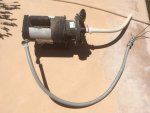Update!
Pool care and water chem all going quite well. I feel I have the FC and pH down, both testing and treating. I'm maintaining my pH close to the high side (7.7) to keep my CSI as close to zero as I can. I haven't tested my CYA since I poured in that first gallon, but I'm assuming it's still around 30. TA seems to have leveled off at about 90. I'm not actively adjusting that any more. Thought I'd just leave it alone for now, and let the slight pH-down adjustments I still have to do tweak the TA (just as you all advised, thank you). The a-tad-high TA is also helping support my near-zero CSI while the water is so cold (44-46°).
Couple questions:
1.
Now that the new pebble break-in is complete (it's been more that 28 days), I've dialed way back on the brushing. I was doing it at least once a day, and even then I never saw any plaster dust (because the plasterers had acid washed the pebble). Given the season (no swimmers), the water temp, the very small amount of debris and leaves, the Rebel running two hours a day, the age of my plaster, and my near-constant FC of 4.5-5.5, what would you recommend for a brushing schedule? Never? Once a week? Once a month?
2.
A bit of a mystery this one... right before I replastered, my now-x-pool-guy spotted what he thought was black algae (small black spots here and there). I had also observed larger patches of green algae, on occasion, during the last months before the first water refill. Given how badly
both the two now-fired pool maintenance companies had been managing my FC, CYA and SWG (usually FC 0 by the end of the week, and an SWG that was never set up correctly), it's no surprise about the algae. But I was quite paranoid about re-infecting the new pebble. I was assured that removing the old plaster would solve for that. And I replaced my filters, too. The only thing I couldn't get at was whatever was lurking in the plumbing. So when I spotted a small black spot on my steps about a week ago, I freaked!!
- The steps are in the shade this time of year, virtually 100% of the time.
- The water is at 45° or so.
- I've been obsessive about FC, the lowest it's been is 4.5 (though I might have hit 3 just once). Usually it hovers aroung 4.5-5.5. I check it every day, occasionally every other day if the last test showed FC 5 or above.
- And I've been brushing regularly, but kind of slacked off right around the time of the black spot!
- I could reach the spot with my hand. It would not rub off.
- I brushed the spot with a nylon brush, it would not brush off (that's when I
really freaked).
Here's the mystery: Now it's gone. I thought I spotted another spot, deeper down, but it's gone now, too. So...
Is there
any possibility this is an algae, black or otherwise? Or were these just leaf or berry stains that stuck around for a while then got eaten up by the chlorine?
Side note! I keep my skimmer basket pretty clean. Never more than a few leaves in there, which I clear out almost every day. Today I dumped the basket and something was moving! Wah? I little frog!! He hopped away. Hope he's OK. Well, now I know my new water chem is at least frog-safe!!





 glad to see you again!
glad to see you again!